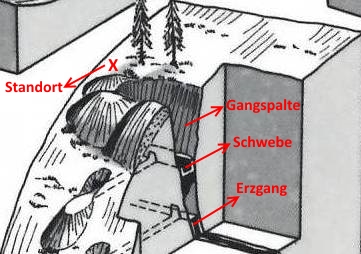A fault pit (German Pinge) is a hollow shaped like a wedge, a ditch, or a funnel which originates from mining, often old surface mining, with near-surface depth. In contrast to natural topographies fault pits and hollow veins are man-made. The German term ‘Pinge’ origins from ‘pingen’, a miners’ term for excavating: a ‘aufgepingter’ vein was a mineral deposit that was excavated near surface. So a ‘Pinge’ was a very simple open pit. Following the ore lode, mining left typical terrains as are preserved from medieval mining in many areas. In ancient times ore was mined in open pit mines. If the ore lode was too thick, supports were left in intervals to avoid a collapse of the stoping. Here you are at the upper edge of an ore gap in the Sinternzeche area, which was working centuries ago already. Originally, the lodes were almost vertically down, but because of safety reasons they were backfilled. This lode starts at the top of Eisernhardt and can be followed down to Eisern valley. Several mines unearthed the ore here: Sinternzeche, Rader, Luempchen, Hoher Hannes, Alte Birke, Handelsmann, Maschinen- and Theatergang are the names of ore lodes where various mines operated.
On behalf of your own security: Stay away from pits and lode gaps, danger of collapse!

Source: M.Döring (Ferndorf):"Eisen und Silber, Wasser und Wald", Verlag die Wielandschmiede, Kreuztal
 view into an lode gap from below ground towards the surface
view into an lode gap from below ground towards the surface


